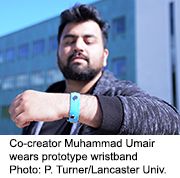MONDAY, July 1, 2019 (HealthDay News) — Remember the “mood ring” craze of the 1970s?
A high-tech wristband is being developed along the same lines, potentially helping patients who struggle with mood disorders.
The smart wristband would use a person’s skin to track their emotional intensity. During a mood swing, either high or low, the wristband would change color, heat up, squeeze or vibrate to inform the wearer he might be in the throes of depression or anxiety, the researchers said.
“As the feedback is provided in real time, our devices encourage people to become more aware of their emotions, name them, potentially reflect on what causes them, and even learn how to control their emotional responses in order to change the visual or tactile feedback provided by the device,” said researcher Corina Sas. She is a professor of human-computer interaction and digital health at Lancaster University in the United Kingdom.
About 10% of U.S. adults struggle with a mood disorder, such as depression, anxiety, bipolar disorder or seasonal affective disorder, according to the U.S. National Institute of Mental Health.
Part of the treatment for a mood disorder involves becoming more aware of emotions, and then learning to regulate emotional response, the study authors said in background notes in their report.
Co-author Muhammad Umair, a Lancaster research associate, explained, “We wanted to create low-cost, simple prototypes to support understanding and engagement with real-time changes in arousal. The idea is to develop self-help technologies that people can use in their everyday life and be able to see what they are going through,” he said in a university news release.
To that end, the U.K. researchers are developing wristbands that use sensors to detect changes in a person’s emotional intensity by tracking the electrical conductivity of their skin.
The devices then communicate those emotional changes either through materials that change color, heat up, vibrate or squeeze the wrist, the researchers said.
Sas said, “Depression has a range of emotions, but if we talk about sadness, then as this is associated with low arousal — or what we call emotional intensity — the device will most likely reflect low arousal. On the other hand, anxiety tends to be associated with high-intensity arousal, so that device will most likely reflect this.”
However, Sas noted, the device does not differentiate between positive or negative emotions, but between high- and low-intensity ones.
The researchers tested six wrist-worn prototypes with 12 people who wore them over two days.
Participants said the wristbands effectively prompted them to evaluate their emotions.
One participant told the researchers: “When I see the feedback, I feel present, I start to reflect what I was doing before and try to think how I am feeling at that moment.”
Another said: “It made me more aware of my feelings and made me think what feelings I have. But if I didn’t have the device, I wouldn’t be probably as aware as I am when wearing it. It did give me a way to think of my own emotion; made me aware of my own emotions.”
But participants were also concerned that negative feedback from the device might pose a potential hazard. One said it could “be used as a trigger and might push you down the negative path.”
That’s a concern shared by Jessy Warner-Cohen, a health psychologist with Long Island Jewish Medical Center in New Hyde Park, N.Y.
“I caution against letting a device dictate to a person their own emotions,” she said.
On the other hand, such a device is consistent with a long-established tradition of biofeedback, in which people use “physiological cues to help us actively try to regulate our minds and bodies,” Warner-Cohen said.
The device could help people recognize specific habits or tics that occur when they have a mood swing, she added.
“For example, if a person can identify that they clench their jaw when stressed then, in reverse, noticing when they clench their jaw can help a person recognize they are getting stressed and take proactive steps to alleviate such,” Warner-Cohen explained.
Dr. Victor Fornari, a psychiatrist with Zucker Hillside Hospital in Queens, N.Y., said the wristbands may be the beginning of “a new frontier” in helping to identify and regulate anxiety and depression.
“Increasing awareness about emotional reactions and improving the way individuals can self-regulate their emotions can be very helpful and important for everyone, but particularly for individuals with a mood or anxiety disorder,” Fornari said.
The technology is not yet patented, Sas said, and it is some ways off from being available to consumers.
“We need about another year to develop a more robust version of our research prototypes so that we can integrate both visual and tactile feedback, for which we will need increased computational power,” she said. “At that stage, we will look into running clinical trials to explore its value for people living with affective disorders, such as depression or anxiety.”
The researchers were scheduled to present their work Friday at the Designing Interactive Systems conference in San Diego, Calif.
Research presented at meetings is typically considered preliminary until published in a peer-reviewed journal.
More information
Johns Hopkins Medicine has more about mood disorders.
Copyright © 2025 HealthDay. All rights reserved.

